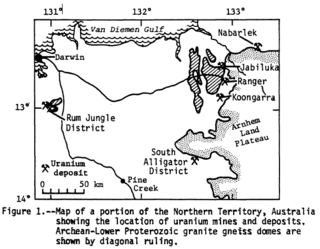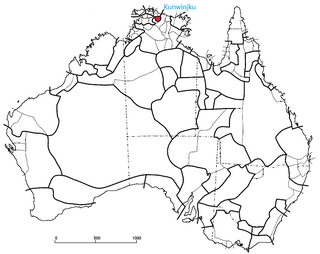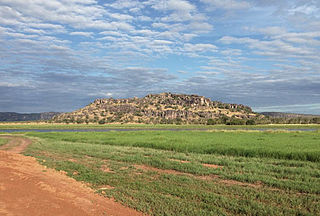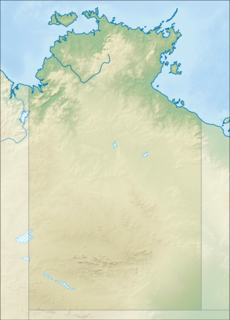Notes and references
Notes
- 1 2 Garde 2009, p. 88.
- ↑ Grimes 2003, p. 96.
- ↑ Garde 2013, p. 39.
Related Research Articles

Kakadu National Park is a protected area in the Northern Territory of Australia, 171 km (106 mi) southeast of Darwin. It is a World Heritage Site.

Arnhem Land is a historical region of the Northern Territory of Australia. It is located in the north-eastern corner of the territory and is around 500 km (310 mi) from the territory capital, Darwin. In 1623, Dutch East India Company captain Willem Joosten van Colster sailed into the Gulf of Carpentaria and Cape Arnhem is named after his ship, the Arnhem, which itself was named after the city of Arnhem in the Netherlands.

Alligator Rivers is the name of an area in an Arnhem Land region of the Northern Territory of Australia, containing three rivers, the East, West, and South Alligator Rivers. It is regarded as one of the richest biological regions in Australia, with part of the region in the Kakadu National Park. It is an Important Bird Area (IBA), lying to the east of the Adelaide and Mary River Floodplains IBA. It also contains mineral deposits, especially uranium, and the Ranger Uranium Mine is located there. The area is also rich in Australian Aboriginal art, with 1500 sites. The Kakadu National Park is one of the few World Heritage sites on the list because of both its natural and human heritage values. They were explored by Lieutenant Phillip Parker King in 1820, who named them in the mistaken belief that the crocodiles in the estuaries were alligators.

Gunbalanya is an Aboriginal Australian town in west Arnhem Land in the Northern Territory of Australia, about 300 kilometres (190 mi) east of Darwin. The main language spoken in the community is Kunwinjku. At the 2016 Australian census, Gunbalanya had a population of 1,116.
Bininj Gun-Wok is an Australian Aboriginal language group which includes six dialects: Kunwinjku, Kuninjku, Kundjeyhmi, Manyallaluk Mayali (Mayali), Kundedjnjenghmi, and two varieties of Kune. Kunwinjku is the dominant dialect, and also sometimes used to refer to the group.
Allosyncarpia ternata, commonly known as an-binik, is a species of rainforest trees constituting part of the botanical family Myrtaceae and included in the eucalypts group. The only species in its genus, it was described in 1981 by Stanley Blake of the Queensland Herbarium. They grow naturally into large, spreading, shady trees, and are endemic to the Northern Territory of Australia. They grow in sandstone gorges along creeks emerging from the Arnhem Land plateau.
Nicholas Evans is an Australian linguist and a leading expert on endangered languages. He was born in Los Angeles, USA.

The Oenpelli python, known in binomial nomenclature as Nawaran oenpelliensis, or Morelia oenpelliensis, is a species of large snake in the family Pythonidae. The species is endemic to the sandstone massif area of the western Arnhem Land region in the Northern Territory of Australia. There are no subspecies that are recognised as being valid. It has been called the rarest python in the world. Two notable characteristics of the species are the unusually large size of its eggs and its ability to change colour.

The black wallaroo, also known as Bernard's wallaroo or Woodward's wallaroo, is a species of macropod restricted to a small, mountainous area in Arnhem Land, Northern Territory, Australia, between South Alligator River and Nabarlek. It classified as near threatened, mostly due to its limited distribution. A large proportion of the range is protected by Kakadu National Park.

The short-eared rock-wallaby is a species of rock-wallaby found in northern Australia, in the northernmost parts of the Northern Territory and Western Australia. It is much larger than its three closest relatives, the eastern short-eared rock-wallaby, the nabarlek and the monjon.
Nabarlek are an Indigenous Roots band from Manmoyi, a tiny community in Arnhem Land, 215 kilometres from the remote community of Gunbalanya (Oenpelli). The band formed in 1985 as a group of singers and dancers with a couple of busted guitars and flour tins for drums. The members are Bininj and they sing in the Kunwinjku language and in English, trying to reach across the cultures. Their songs are traditional songs of the Kunwinjku people of western Arnhem Land with a rock/reggae arrangement. They call themselves the garage band that never had a garage.

The Gunwinggu (Kunwinjku) people are an Australian Aboriginal people, one of several groups within the Bininj people, who live around West Arnhem Land to the east of Darwin, Northern Territory. Kunwinjku people generally refer to themselves as "Bininj" in much the same way that Yolŋu people refer to themselves as "Yolŋu".

Injalak Arts is a non-profit, community owned Aboriginal art centre located in Gunbalanya in West Arnhem Land in the Northern Territory of Australia. It was incorporated in 1989. It is known for artists working in a primarily figurative style, and continuing and developing the West Arnhem rock art tradition. It is also known for pandanus weavings. Artists are mostly Kunwinjku people; however, artists from many language groups across Arnhem Land are represented. While working within the continuous art history of the Arnhem region, Injalak Arts is part of the wider contemporary Aboriginal Art movement, which has made a large impact on the Australian and international art world.

The Goomadeer River is a river in the Northern Territory, Australia.
Bobby Barrdjaray Nganjmirra was a Kunwinjku Aboriginal artist of the Djalama clan and Yirridjdja moiety. He was born around 1915 at Malworn in West Arnhem Land, growing up primarily in a traditional lifestyle despite short periods spent at school in Gunbalanya and on Goulburn Island. He is amongst the best known of the early modern Kunwinjku bark painters and was a contemporary of artists such as Bardayal 'Lofty' Nadjamerrek and Yirawala.
The Maung people, or Warruwi, are an Aboriginal Australian people living on the Goulburn Islands, in the Arafura sea off the coast of the Northern Territory.
The Bininj are an Aboriginal Australian people of Western Arnhem land in the Northern Territory. The sub-groups of Bininj are sometimes referred to by the various language dialects spoken in the region, that is, the group of dialects known as Bininj Gun-Wok; so the people may be named Gunwinggu, the Kuninjku, Kundjeyhmi (Gundjeihmi), Manyallaluk Mayali, Kundedjnjenghmi and Kune groups. In addition, there are clan groups such as the Mirrar who are prominent in matters relating to looking after the traditional lands.
The Dalabon or Dangbon are an Australian Aboriginal people of the Northern Territory.
The Gaagudju, also known as the Kakadu, are an Aboriginal Australian people of the Northern Territory.
Wanurr Bob Namundja (c.1933–2005) was an Aboriginal Australian artist known for his bark paintings.
References
- Garde, Murray (2009). "The language of fire: seasonality, resources and landscape burning on the Arnhem Land Plateau". In Russell-Smith, Jeremy; Whitehead, Peter; Cooke, Peter (eds.). Culture, Ecology and Economy of Fire Management in North Australian Savannas: Rekindling the Wurrk Tradition. Csiro Publishing. pp. 85–164. ISBN 978-0-643-09999-9.
- Garde, Murray (2013). Culture, Interaction and Person Reference in an Australian Language: An ethnography of Bininj Gunwok communication. John Benjamins Publishing. ISBN 978-9-027-27124-2.
- Grimes, B (2003). "Giimbiyu languages". In Frawley, William (ed.). International Encyclopedia of Linguistics: AAVE-Esperanto. 1. Oxford University Press. p. 96. ISBN 978-0-195-13977-8.